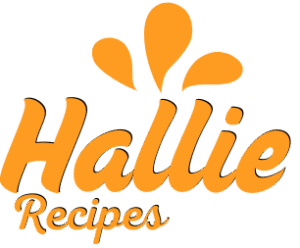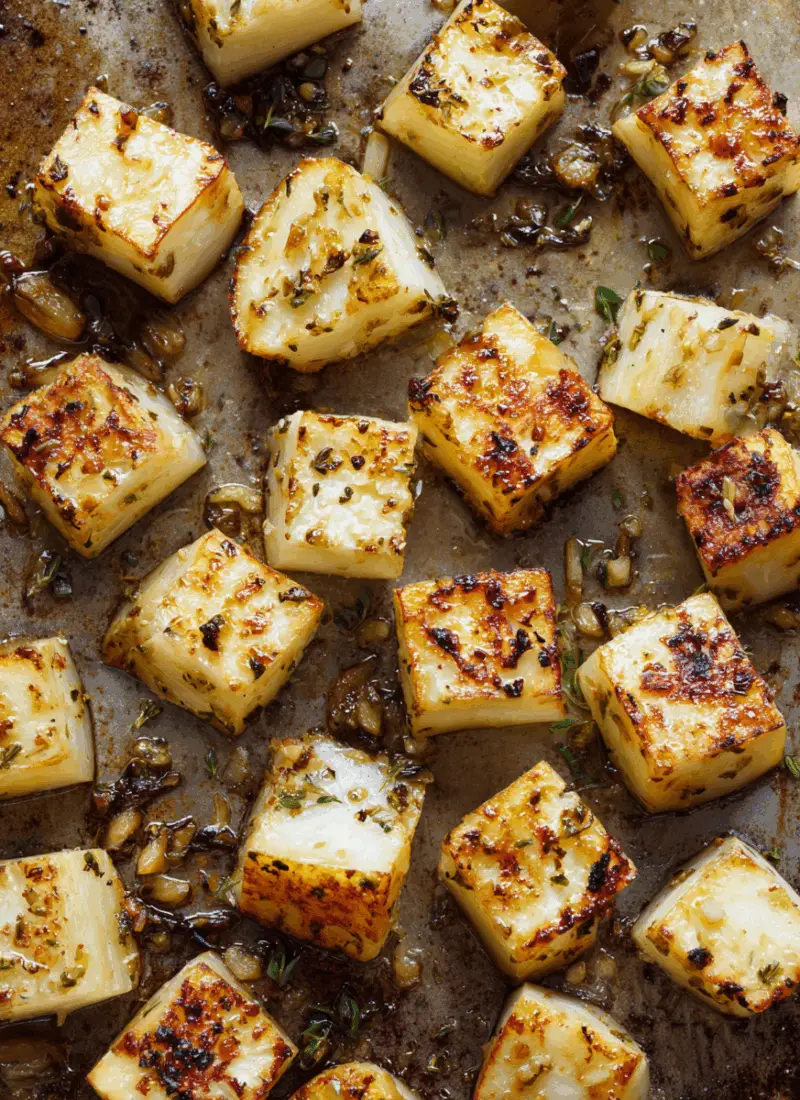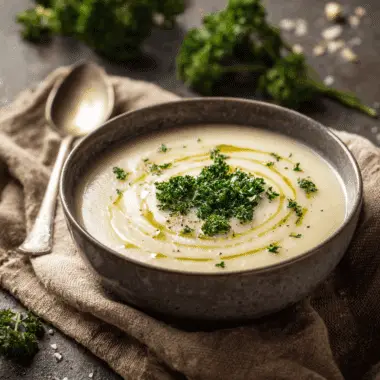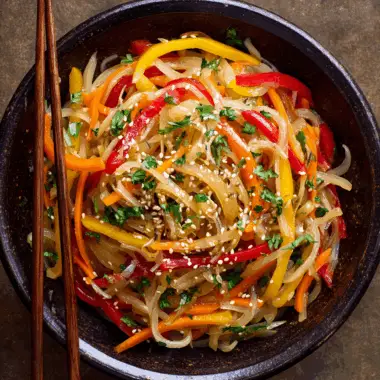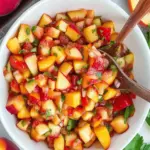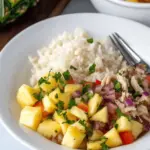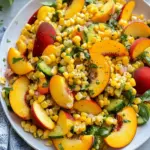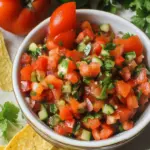Garlic Roasted Kohlrabi is a simple and flavorful side dish that brings out the natural sweetness and nuttiness of this underrated vegetable. With just four ingredients, it transforms into golden, crispy cubes that are tender inside and lightly caramelized on the outside. Perfect alongside roasted meats, tossed into grain bowls, or served as a healthier alternative to fries, this dish is a must-try for kohlrabi lovers and newcomers alike.
FULL RECIPE
Ingredients
- 2 medium kohlrabi bulbs, peeled and diced into ½-inch cubes
- 2 tablespoons olive oil
- 3 cloves garlic, minced
- Salt, to taste
Directions
- Preheat oven to 400°F (200°C).
- Prepare the kohlrabi by removing the leaves and peeling the tough outer layer. Dice into uniform ½-inch cubes to ensure even roasting.
- Toss the kohlrabi cubes in a large mixing bowl with olive oil, minced garlic, and a pinch of salt. Mix well to coat evenly.
- Spread the seasoned kohlrabi on a baking sheet in a single layer, ensuring there is space between the pieces for proper roasting.
- Roast in the preheated oven for 25–30 minutes, turning once halfway through, until the edges are golden brown and the centers are fork-tender.
- Serve warm, optionally garnished with fresh herbs like parsley or thyme if desired.
Nutrition Facts
- Calories: 110
- Total Fat: 7g
- Saturated Fat: 1g
- Trans Fat: 0g
- Cholesterol: 0mg
- Sodium: 100mg
- Total Carbohydrates: 11g
- Dietary Fiber: 4g
- Sugars: 5g
- Protein: 2g
- Vitamin C: 90% DV
- Calcium: 4% DV
- Iron: 3% DV
Nutritional Value of Kohlrabi
Kohlrabi is a powerhouse of nutrients while being low in calories, making it ideal for health-conscious eaters. It is particularly rich in vitamin C, which supports immune function, collagen production, and antioxidant protection. Additionally, it provides fiber for digestive health and a range of B vitamins that support metabolism and energy production. It contains phytochemicals like glucosinolates and isothiocyanates, compounds known for their potential anti-inflammatory and anticancer properties. When paired with olive oil and garlic, the dish remains nutrient-dense while adding heart-healthy fats and additional antioxidants to the mix.
Health Benefits of Garlic
Garlic is not only a flavorful addition to this recipe—it’s also a nutritional ally. Known for its medicinal properties, garlic has been linked to lowered blood pressure, improved cholesterol levels, and immune-boosting effects. It contains compounds such as allicin, which exhibit antibacterial, antifungal, and antiviral properties. Including garlic in your meals can support cardiovascular health and may reduce the risk of chronic diseases. When roasted, garlic mellows in flavor but retains its health benefits, making it a perfect partner for vegetables like kohlrabi.
Perfect Pairings and Serving Suggestions
Garlic Roasted Kohlrabi pairs well with a wide variety of main dishes due to its balanced flavor and versatility. It complements roasted meats such as chicken, pork, or lamb, especially when seasoned with herbs like rosemary or thyme. For vegetarian meals, it works beautifully alongside lentil loaf, grilled tofu, or a hearty grain bowl with quinoa or farro. It can also be served over a green salad, mixed into warm pasta, or layered in wraps and sandwiches. A sprinkle of fresh parsley or a drizzle of lemon juice before serving adds a refreshing brightness to balance the savory garlic.
Creative Variations to Try
While the basic recipe uses only four ingredients, there’s ample room for creative variations to suit different tastes. For a spicier version, try adding crushed red pepper flakes or a dash of cayenne. You can also experiment with spices like cumin, smoked paprika, or curry powder for a more global flair. Adding grated Parmesan cheese in the last five minutes of roasting will create a crispy, savory crust. For a vegan twist on cheesy flavor, nutritional yeast works well. Roasting with other root vegetables like carrots, parsnips, or sweet potatoes can also add color and texture to the dish.
Tips for Roasting Kohlrabi Perfectly
To ensure that your Garlic Roasted Kohlrabi turns out perfectly every time, uniform slicing is key. Cutting the kohlrabi into evenly sized pieces promotes consistent roasting, preventing some cubes from burning while others remain undercooked. Spacing the pieces out on the baking sheet helps them roast rather than steam—overcrowding leads to soggy textures. For extra crispiness, preheat the baking sheet in the oven before adding the kohlrabi. Tossing the garlic in halfway through the roasting time, rather than at the beginning, can also prevent it from burning and turning bitter.
Storage and Reheating Advice
Leftovers of Garlic Roasted Kohlrabi store well and can be refrigerated in an airtight container for up to 4 days. To maintain texture, reheating in the oven or air fryer is recommended, as microwaving may soften the crispy edges. When reheated properly, the kohlrabi retains much of its roasted flavor and makes an excellent addition to breakfast scrambles, grain bowls, or even used as a warm salad topper. It’s not recommended for freezing, as the texture can become mushy once thawed, but it’s easy enough to make fresh whenever a quick side dish is needed.
How to Select and Prepare Kohlrabi
For the best flavor and texture, choose firm kohlrabi bulbs that are free from soft spots or blemishes. Smaller bulbs are usually more tender and mildly sweet, while larger ones can become woody and fibrous. The leaves, if attached, should be vibrant and green—a sign of freshness. Before cooking, peel the outer layer with a sharp knife or vegetable peeler to remove the tough skin. Rinse the bulb thoroughly to remove any dirt, and cut into uniform cubes or wedges depending on your desired presentation. Don’t discard the leaves—they can be sautéed or added to soups like kale or collard greens.
Seasonal and Local Eating
Kohlrabi is in season during the cooler months of spring and fall, although it’s available year-round in many grocery stores. Supporting local farmers by purchasing fresh, locally grown kohlrabi ensures better flavor, less environmental impact, and higher nutrient retention. When in season, kohlrabi is at its peak sweetness and crunch, making it a star ingredient for roasted dishes like this one. It’s often found in farmers’ markets or in CSA boxes, giving you the perfect opportunity to discover or rediscover this underrated vegetable.
Sustainability and Minimal Waste Cooking
Garlic Roasted Kohlrabi is a sustainable recipe that aligns well with zero-waste cooking goals. From using locally grown produce to utilizing every edible part of the plant, this dish minimizes waste and maximizes value. The kohlrabi greens can be sautéed or blended into pesto, while the trimmings can be used to flavor stocks. Garlic skins can also be composted or used to infuse broths. Using just four basic ingredients also reduces packaging waste and supports simple, eco-conscious cooking without compromising flavor or nutrition.
Conclusion
Garlic Roasted Kohlrabi is more than just a side dish—it’s a celebration of simplicity, nutrition, and versatility. Whether you’re discovering kohlrabi for the first time or looking for a new way to enjoy this underappreciated vegetable, this recipe offers a delicious, health-forward option that’s easy to make and hard to forget. With endless possibilities for variations, pairings, and uses for leftovers, it’s a dependable addition to any kitchen repertoire. Its balance of flavor, texture, and wholesome ingredients makes it a go-to choice for anyone seeking to eat well without sacrificing convenience or taste.
